Photo Corners headlinesarchivemikepasini.com
![]()
A S C R A P B O O K O F S O L U T I O N S F O R T H E P H O T O G R A P H E R
![]()
Reviews of photography products that enhance the enjoyment of taking pictures. Published frequently but irregularly.
We Test Epson's Natural Canvas


6 March 2013
We've been having our bust sculpted in marble. It's taking years. And years. The guy keeps getting distracted with tombstones. A quicker route to immortality (as any portrait photographer can tell you) is the print made on canvas.
Canvas says art. And a portrait on canvas says VIP. Very Impressive Portrait.
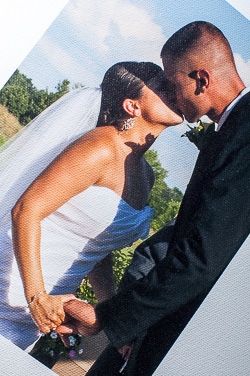
A Match. Canvas color matched the color on our glossy prints of the same images.
In October last year, Epson introduced Signature Worthy canvases with Gloss Natural, Satin Natural and Matte Natural surfaces. That's what the company's previous canvas options were. But the big news was that the new Exhibition Canvas Natural media do not use optical brighteners, are much lighter weight, and yet are still quite bright.
BRIGHTENER-FREE
Jeff Smith, product manager for Epson America, explained, "Our media engineers went through a rigorous process to develop an OBA-free canvas that maintains bright whites, deep blacks and a wide color gamut that meets the demanding requirements of a Signature Worthy media."
How does it compare to the old canvas with brighteners? Very close. Epson told us the Lab color space values for the old gloss-surface canvas are 96.31, -0.96, 1.6 while the new gloss surface without brighteners measures 94.4 -0.9 -3.2.
We compared the Satin Natural canvas to a sheet of Ilford Galerie Smooth Gloss paper. There was no cream-color cast, typical of non-OBA surfaces, to the canvas.
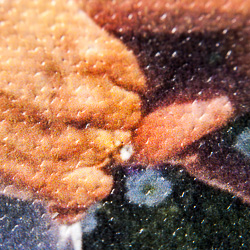
Rich Color. Sharp detail in this macro shot of 5x7 wedding print.
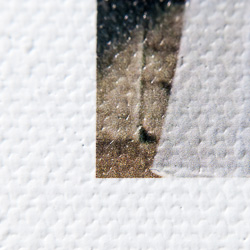
Detail. Good ink hold-out from same image.
We were impressed enough with the brightness of the new surface that we have to wonder if this OBA-free technology might not make an appearance on Epson papers, too. Epson told us it doesn't have any plans to do so but you plant a seed and sometimes something grows.
WEIGHT
Constructed on a flexible base of blended cotton and polyester, the 19 mil thick Exhibition Canvas Natural media is also significantly lighter in weight than the company's previous canvas offering.
That plus its improved flexibility makes it easier to stretch a canvas over a gallery wrap for framing. And the lower weight cuts down on shipping costs as well.
TESTING
The company sent us a 13-inch roll of each for testing and we've been working on it, printing reproductions we captured of works in the permanent collection of the de Young Museum.
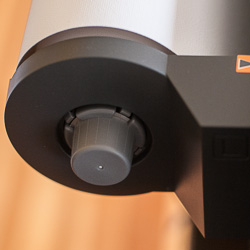
Let's Roll. The R3000 includes two roll holders.
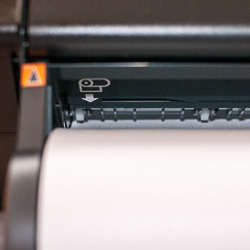
Feed. Canvas feeding was foolproof in both forward and reverse.
But until a few days ago, we labored in obscurity because the company hadn't released any ICC profiles for the canvases. We did get good results using driver settings recommended by Epson for either the Gloss or Satin finishes: Ultra Premium Photo Paper Lusture media setting, Photo RPM quality setting and AdobeRGB (or Epson Standar sRGB) color setting, letting the printer manage color.
But there's nothing like an ICC profile designed for your printer. Unfortunately, we can't find the R3000 profiles we're using on the Epson site. Epson sent them to us directly. But they do exist.

Custom Paper Size. Our setup for rolls.
CUSTOM PAPER SIZE
The trick to printing on canvas is to set up a custom paper size in your Print dialog. We set a width of 12.95 inches (which you can't argue with) and height of just 9.0 inches to minimize paper waste. We didn't designate any non-printable area.
This worked very well for our de Young painting (which is about 8x12) but does generate some waste on smaller prints like the 5x7 shown in the illustrations. Not enough, though, to set up another width.
The R3000 itself handled the canvas very well. When printing is complete, you do have to run over to it to use the control panel to print a cut-out line. After you cut the print from the rest of the canvas with a pair of scissors, you use the control panel again to roll the paper back onto the feed roll.
Works like a charm. In fact, we had the impression there was some small assistant hiding under the printer rolling the paper back and forth for us.
THE PRINTS
Canvas is canvas. It's what lies under an oil painting, not a watercolor. And it can be a little silly to use a watercolor filter on your image to print it on canvas. Even when the oil painting filters are less convincing as paintings.
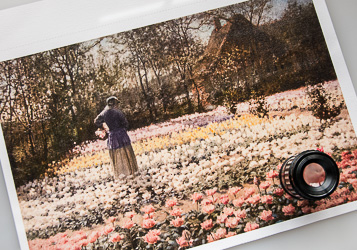
Art Reproduction. Excellent color reproduction.
Instead, we preferred, generally, to skip the art filter and just print the photo, as we did with the wedding shot illustrated above.
Epson told us the Gloss and Satin profiles use the "Luster" setting while the Matte profile uses the "UltraSmooth" setting. That's pretty much all we needed to know.
We were particularly impressed with the color reproduction. This image came from the same set of images as the photo coasters. Those images were printed on a Canon Pro-10, which uses pigments like the R3000 but they were printed on a high gloss Kodak porous sheet. Sitting side-by-side, the colors match. The sky is the same blue, the suits as black, the greenery the same range and the white dress the same, too.
CONCLUSION
We've really enjoyed printing on the new OBA-free canvases from Epson. They aren't for every image, but they do dress up our fine art reproductions nicely. And for special images destined for immortality, they're quicker than the guy working on my bust.
And the color is just what we had hoped to see: faithful to high quality prints.
Outright prolonged applause. And Epson's Signature Worthy Exhibition Canvas Natural media earns four photo corners, too.
Comments
I enjoyed the article a lot. Can the author possibly send me the ICC profile for this canvas? (Since its not on Epson's Web page.)
-- Miklos Abert
Oh, they do put them up, Miklos, but they hide them <g>. You'll find them on this page: Premium ICC Printer Profiles for the Epson Stylus Photo R3000. -- Mike